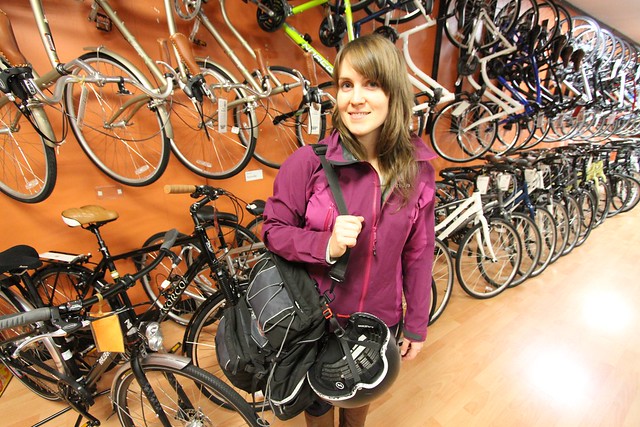By David Dodge and Duncan Kinney
As anybody who has seen astronaut Chris Hadfield’s incredible images from space can attest, the single most prominent human-made features of cities like Toronto, Windsor or Edmonton are roads. As seen from space the new Anthony Henday ring road forms a dramatic necklace around our home base of Edmonton.
Ever since the 1950s the car has been the accidental architect of our cities. Billions of dollars have been dedicated to roads, overpasses, tunnels and other car infrastructure.
But this single minded dedication to making sure cars got to where they wanted to go as fast as they could has had some pretty serious unintended consequences.
As our country becomes more and more urban it’s clear that while our cities will continue to grow in size and population there’s only so many roads that lead to the places people want to go. This leads to everyone’s favourite way to wile away a few hours a day – traffic gridlock.
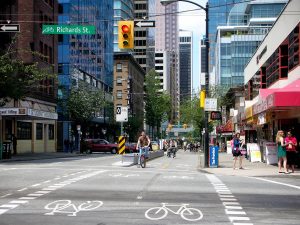
The separated bike lanes on Dunsmuir in Vancouver. Photo by Vanessa K.
As Andrew Coyne says in Macleans “Traffic is slowly strangling our cities.” Increasing traffic uses more fuel, increases pollution and commute times and Coyne quotes a German study which finds that “being in heavy traffic triples your risk of a heart attack within an hour.”
Enter the bicycle. It is the most efficient form of transportation on the planet. You can move five times faster than walking and go three times as far on the same amount of caloric energy. Cars use 50 to 80 times more energy than a bike to travel the same distance and as any public heath expert will tell you North America is suffering from rising obesity rates.
As a popular expression on the internet says your bike runs on fat and saves you money while your car runs on money and makes you fat.
The benefits of the bicycle certainly were not lost on the City of Vancouver when it decided to flip the traditional urban script.
“Cycling is our second highest priority in the transportation system. Since 1997 we established priorities with walking being the highest priority, cycling second, transit third, and the automobile is at the bottom of the list,” says Jerry Dobrovolny, the director of transportation with the City of Vancouver.
And unlike cities that dabble in making their cities more bike-friendly Vancouver has actually dramatically increased the use of bikes and decreased traffic congestion in downtown Vancouver.
VANCOUVER’S DESIGN SUCCESS
Jerry Dobrovolny is a six-foot-six former pro football player who has presided over the startling growth in cycling in Vancouver. According to Dobrovolny trips have gone up by 180 per cent over the past 15 years and the amount of people cycling to work has grown from 3.5 per cent to 4.5 per cent.
In fact, 12 out of every 100 trips in Vancouver are done via bicycle today.
And they did it not by focusing on the middle-aged-man-in-lycra, or MAMIL for short, but by building bike infrastructure that kids and grandmas and people that aren’t super proficient bike riders would feel comfortable using.
“We know that there’s many people that are interested in cycling, but they’re not comfortable riding next to cars,” says Dobrovolny..
“We feel that we can get the 60 per cent that we know from studies that are interested in trying to cycle… we feel confident that we can get them out on their bikes.”
Nearly all cities have bike lanes, but paint on the road just isn’t safe enough for kids, seniors and non-MAMILs. Instead Vancouver is using separated bike lanes and bike boulevards.
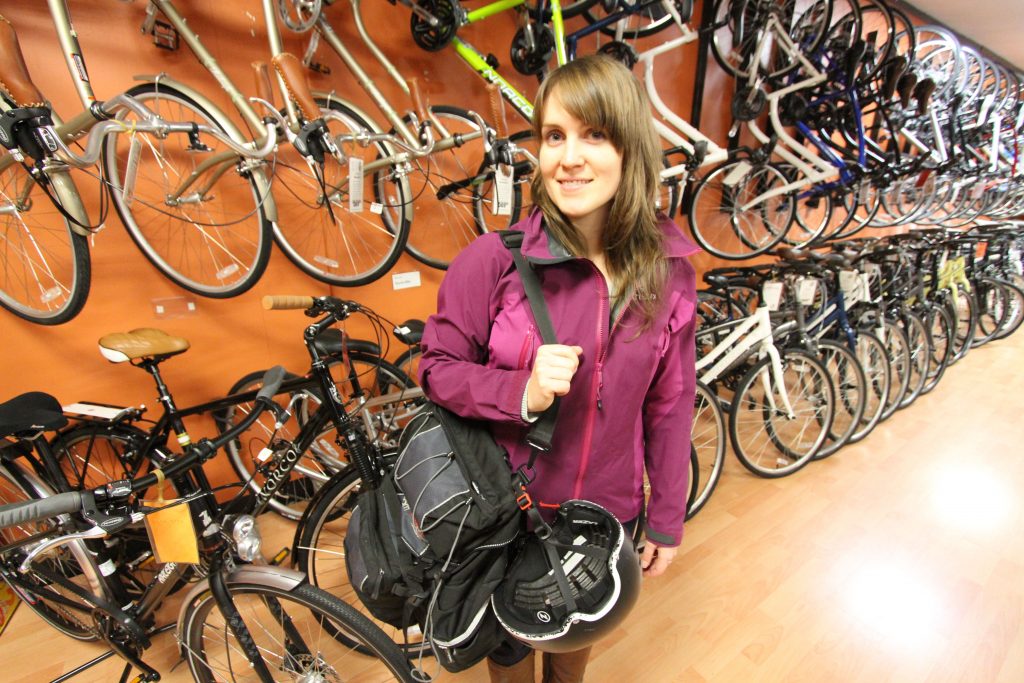
Erin O’Melinn is the executive director of HUB, Vancouver’s largest advocacy group. “Since the separated lanes have gone in downtown we’ve seen a big reduction in the number of collisions of all types, including the number of people riding on sidewalks, so pedestrians feel much more comfortable,” says O’Melinn.
Separated bike lanes are dedicated lanes built only for cyclists that are physically separated from cars. Bike boulevards are repurposed residential streets that have been made bike friendly. “It’s a regular street, but it’s been designed so that bikes generally have the right of way,” says Erin O’Melinn, the executive director of Hub, Vancouver’s largest cycling advocacy organization.
I went for a tour of around parts of downtown Vancovuer with O’Melinn and it was remarkably easy to get around on a bike.
There is green paint and stencils on the road helping carve space for cyclists, there is clear signage and on the bike boulevards there are single-lane roundabouts to slow down cars and barriers that stop cars but let bikes through.
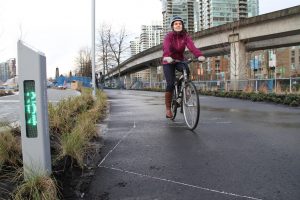
Erin O’Melinn is the executive director of HUB, Vancouver’s largest cycling advocacy organization. Here she rides by a bike counter.
This calms traffic on the street and encourages people to bike, because they don’t have to interact with as many vehicles, says O’Melinn.
These bike boulevards are great for residential areas and there is quite an extensive network of them in Vancouver but it’s the separated bike lanes that are the real game changer.
Separated bike lanes on the Dunsmuir Viaduct saw four times more cyclists using the road. Safety has improved as well.
“Since the separated lanes have gone in downtown we’ve seen a big reduction in the number of collisions of all types, including the number of people riding on sidewalks, so pedestrians feel much more comfortable,” says O’Melinn.
FINANCIAL SENSE
Reducing pollution and improving health are great reasons to invest in cycling, but another reason is it’s that it’s cheap like borscht.
“Whereas heavy trucks and buses and automobiles break down the road infrastructure and result in a lot of added costs in terms of maintenance. When we build a pedestrian or bike facility they last for 100 years,” says Dobrovolny.
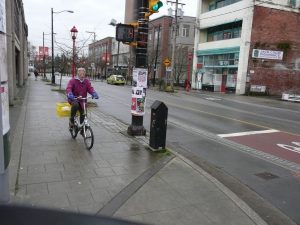
Rates of cycling for seniors, women and families have gone up in Vancouver. Photo by Brent Granby
In 2010 Vancouver’s city council approved a $25 million 10-year bike plan. For comparison the Canada Line, the new rapid transit line from Vancouver to Richmond that was built in time for the Olympics cost $2 billion dollars. Estimates for the planned North Fraser Perimeter Road are in the order of $3 billion.
When it comes to the household budget the bike fares quite well. Forget the sticker price of your car, the Automobile Association of America estimates the average cost of operating a car at around $9,000 a year. The estimated operating cost of a bike? Around $400. That leaves plenty of cash for cabs, car rentals or bus fare when the bike isn’t the best choice.
With transportation at roughly 10 to 15 per cent of an average household’s budget it’s worth finding fat to trim.
THE TIPPING POINT FOR VANCOUVER
Heather Deal is Vancouver city councilor who was involved when the city decided to convert a whole lane of traffic on the Burrard Bridge into a bike lane.
“That was the first time we took space away from cars. I was assigned the media, I thought this is the last time I’ll ever get elected because I’m going down over one kilometre of one lane for traffic,” says Deal.
“That day came and we had hundreds of cyclists at the edge of the bridge waiting to cross when we cut that ribbon at 7 a.m. There were news helicopters circling overhead. There was a radio station that had put up a booth to interview cars while they were caught in the inevitable traffic jam that was going to happen.”
“We cut that ribbon and we cycled across that closed lane and nothing happened. There was no traffic backup. There was no armageddon. Chaos did not ensue. The city survived and so did we. We went on to get reelected and build more bike lanes after the next election.”
While Vancouver certainly has some climatic advantages that other cities don’t that hasn’t stopped winter cities like Minneapolis and Montreal from investing in cycling infrastructure.
In fact, cold and frigid Minneapolis was just recently named the best bike city in the US.
And in Vancouver what looked like a confrontational move to take space away from cars actually wound up creating more space for cars and a new, safer space for bikes, a pleasant surprise for Heather Deal and her colleagues on council.

